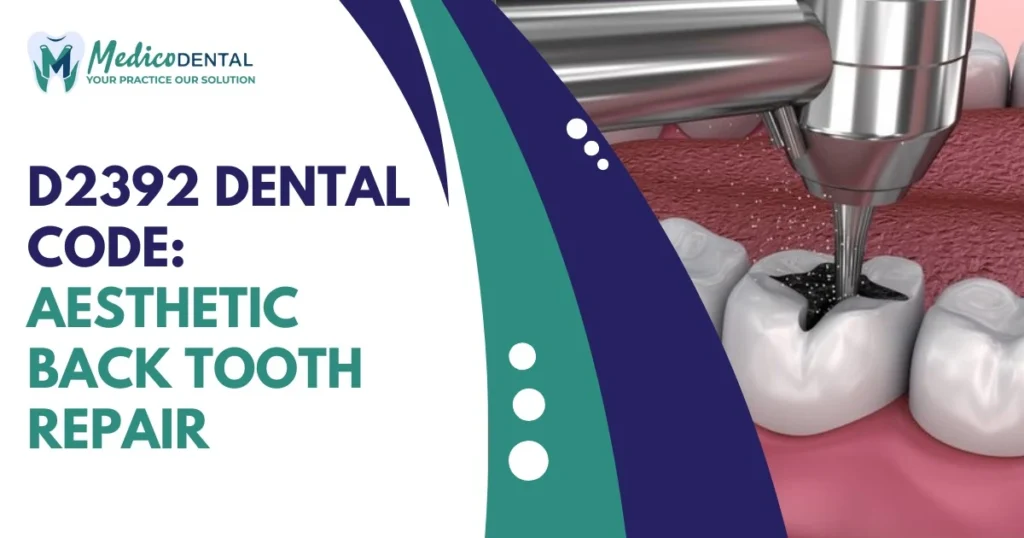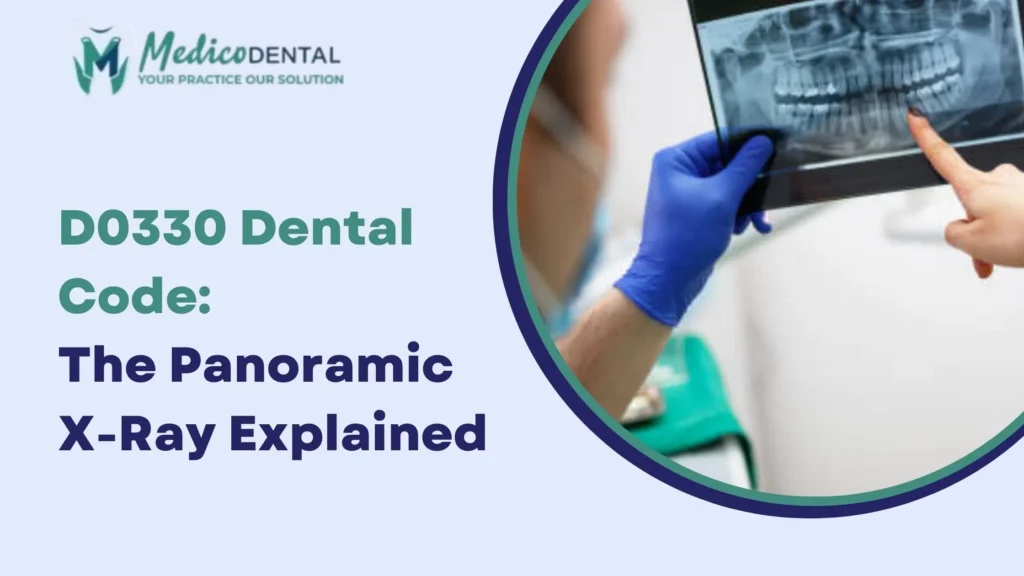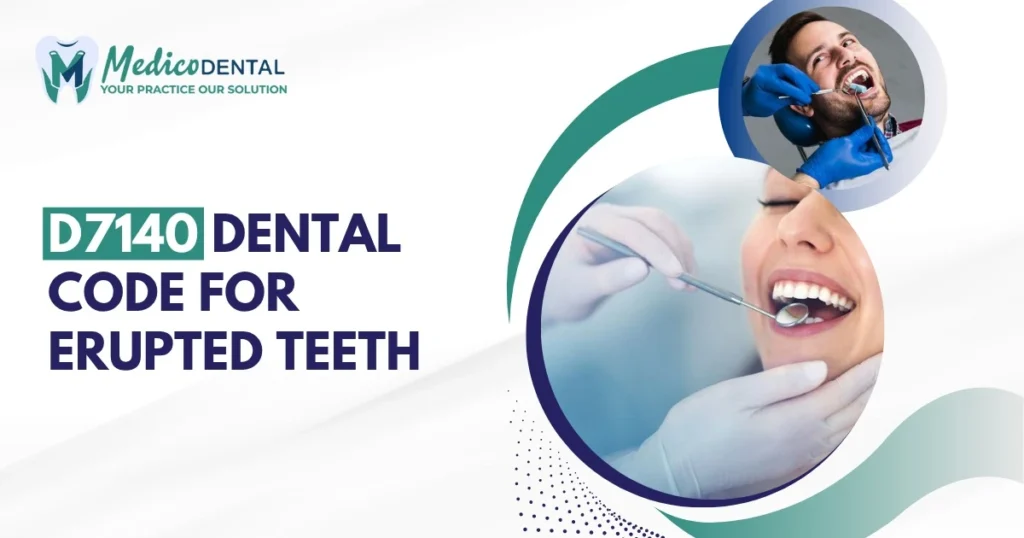The D2392 dental code is used for a resin based composite restoration on posterior teeth that involves two surfaces, typically on molars or premolars. This procedure is often performed to repair damage from decay or fractures, offering both aesthetic and functional benefits. By using this code, dental professionals can accurately report the treatment while ensuring proper reimbursement from insurance providers. Understanding the details of D2392 helps ensure that both dentists and patients receive the full benefits of this restorative treatment.
What Is D2392 Dental Code and Why Does Dentistry Need It?
A resin based composite restoration with two surfaces impacted by decay, fracture, or injury is referred to by the dental code D2392. This number is crucial to dental billing and coding since it aids dentists in correctly classifying and reporting restorative operations. It’s crucial since it ensures appropriate payment for the services rendered by streamlining communication between insurance providers and dental facilities.
Understanding D2392 is essential for dentists because it enables them to determine the best course of action for patients with posterior teeth that have two surface damage, guaranteeing that they are providing effective care. By ensuring that the restoration work is funded, this code lessens the administrative load and frees up experts to concentrate on patient care.
Comprehending Composite Restorations Based on Resin
Resin Based Composite: What Is It?
Dental restorations employ tooth colored materials called resin based composites. They are made up of filler materials like glass or quartz mixed with a resin matrix. These materials are often used for visible dental restorations because of their exceptional ability to blend in with the color of natural teeth. In addition to restorative procedures like D2392, many patients also receive D1206 fluoride treatments, which help protect their teeth from further decay and maintain overall oral health after the restoration process.
Because resin based composites are easily sculpted to mimic the tooth’s natural curves, they provide both cosmetic and practical advantages over conventional amalgam fillings. They are frequently utilized in posterior teeth restorations, such as those denoted by the D2392 code, since they chemically attach to the tooth structure, adding strength and stability.
Why Choose Resin for Restorations?
Composites made of resin provide a number of benefits:
Aesthetic Appeal
The material is a popular option for visible dental repairs since it closely resembles the natural color of teeth.
Bonding Strength
Composite resin clings firmly to the tooth structure, guaranteeing the restoration’s long term stability.
Versatility
Resin composites are perfect for a variety of restorative treatments since they may be applied to both anterior and posterior teeth.
Conservative Approach
By keeping the natural tooth structure intact, these fillings need less removal of healthy dental material than more conventional materials like amalgam.
Selecting resin for restorations guarantees that the tooth’s look and function are successfully restored, particularly in posterior teeth.
Information about the D2392 Dental Code
D2392 Dental Code: What Does It Mean?
The term “D2392” describes a two surface restoration on a posterior tooth made of a composite material based on resin. The molars and premolars toward the rear of the mouth are called posterior teeth, and they are utilized for grinding and chewing food. In particular, the D2392 code is used when two of these teeth’s surfaces are impacted by decay or injury.
A two surface restoration is a sign that the decay or damage has spread to both of the tooth’s surfaces, such as the proximal (side) surface and the occlusal (chewing) surface. For instance, D2392 might be used to fix a molar that has decay on both the top and one side.
Two Surface Restoration: What Does It Include?
A two surface restoration involves applying a composite material to two different tooth surfaces, usually the proximal (the side) and occlusal (the biting or chewing) sides. This restoration technique ensures that the tooth may continue to function normally while preserving its natural look by restoring its function and halting more decay.
For instance, the dentist might classify the restoration operation using D2392 if the patient has cavities on one side of their molar and on the biting surface. This number indicates that the tooth’s two surfaces rather than simply one were restored.
Why D2392 is Used for Posterior Teeth
Because of their placement and the pressure they experience when chewing, posterior teeth (molars and premolars) are more vulnerable to decay, which is why D2392 is used on them. Because of their bigger surfaces and additional grooves that can catch food particles and germs, posterior teeth are more prone to cavities.
The likelihood of injury is increased since molars and premolars are subjected to higher wear and tear because they are also utilized for food grinding. D2392 is therefore frequently utilized when posterior teeth need to be repaired due to decay or damage affecting two surfaces.
When Does Dental Procedures Use D2392?
Typical Dental Operations Using D2392
D2392 is frequently utilized in posterior tooth restorations or fillings. It is particularly employed when the damage or decay is severe enough to impact many surfaces but not so bad that a bigger repair (such a crown or three surface restoration) is required.
D2392 is frequently used for the following procedures:
- Filling up cavities on a molar’s chewing and lateral surfaces.
- repairing a premolar that has been traumatized.
- treating dental decay that affects the tooth’s side and chewing surface.
In these situations, D2392 aids in restoring the tooth’s function and look without necessitating a lengthy repair.
Indications for Two Surface Resin Based Restorations
The D2392 code is used when:
- There is decay or damage on two surfaces of a posterior tooth.
- The dentist chooses a resin based composite as the restorative material due to its aesthetic and functional properties.
- The damage is not severe enough to require a larger restoration like a crown.
In general, this code is used when the damage is confined to the top (chewing) surface and one side of the tooth, providing an efficient and cost effective way to restore the tooth.
Distinguishing D2392 from Other Dental Codes
D2391 vs D2392 vs D2393: Understanding the Differences
Understanding the differences between D2391, D2392, and D2393 is crucial for accurate dental coding:
- D2391: This code is applied to a posterior tooth that has a single surface composite restoration made of resin. It is applied when decay only affects one surface, such as the occlusal, mesial, or distal.
- D2392: Applied to posterior teeth for a two surface composite restoration made of resin, usually including the proximal and occlusal surfaces.
- D2393: When decay affects three surfaces of a tooth, this code is utilized for a three surface resin based composite repair on the back of the tooth.
The main distinction between these codes lies in the number of surfaces involved in the restoration, with D2392 specifically dealing with two surfaces on posterior teeth.
Why D2392 Is Not Used for Anterior Teeth
D2392 is not intended for use with front teeth (front teeth), but rather with posterior teeth (molars and premolars). Because of their size, position, and the aesthetic needs of front teeth, front teeth often require a distinct kind of composite repair.
The proper designation for a two surface resin based composite in anterior teeth would be D2331. This is because front teeth require different restoration techniques than posterior teeth due to their distinct functional and cosmetic requirements. A distinct strategy is needed to guarantee that the restoration fits in perfectly with the natural tooth because anterior teeth are more noticeable.
Dental offices may make sure they are adhering to industry standards and that insurance companies are aware of the particulars of the operation being carried out by utilizing the appropriate code for anterior vs posterior teeth.
The Benefits of Using D2392 Code
The D2392 code is widely used for resin based composite restorations on posterior teeth that involve two surfaces. This code not only helps dentists classify and report dental procedures accurately, but it also has several benefits that are valuable both for dental professionals and patients.
Aesthetic and Functional Benefits of Resin Based Composites
One of the main advantages of using resin based composites in restorative dentistry is their aesthetic appeal. These composite materials are tooth colored, meaning they blend seamlessly with the natural shade of the tooth, making them an excellent choice for posterior restorations. In the case of D2392, which involves a two surface restoration, patients can benefit from a functional and aesthetically pleasing result.
Functionally, resin based composites also outperform older filling materials like amalgam. They bond chemically to the tooth structure, adding strength and providing better support. Since posterior teeth are essential for grinding food, it’s crucial that the restoration mimics the tooth’s natural function, and resin based composites excel at doing just that.
Another reason resin based composites are preferred is that they require minimal removal of tooth material, preserving the integrity of the tooth while still providing the needed repair. For both aesthetic and functional reasons, D2392 is an excellent choice for restoring two surface damage in posterior teeth.
Long Term Durability and Patient Satisfaction
Resin based composites are known for their long lasting durability. Once placed, these restorations can last for many years, with proper care and maintenance. While no restoration is permanent, composite fillings generally last longer than many people expect, especially when done with the proper technique. D2392, in particular, is suitable for restoring posterior teeth where the filling will endure chewing forces regularly.
Patients who receive restorations using the D2392 code generally report high levels of satisfaction due to both the aesthetic results and the improved functionality of their teeth. Since these restorations are not only durable but also visually appealing, patients feel more confident in their smile, especially with a restoration in the back of the mouth where they may feel self conscious about traditional fillings.
How to Properly Utilize the D2392 Code
Utilizing the D2392 code correctly is essential for accurate billing and reporting, as well as to ensure proper reimbursement from insurance providers. Revenue cycle management plays a key role in this process by overseeing the entire billing cycle, from claim submission to payment collection. When managed effectively, revenue cycle management ensures that claims related to D2392 are processed promptly, minimizing denials and ensuring timely payments for the dental practice.
Correct Coding Practices for D2392
To make sure the D2392 code is used appropriately:
Verify the Restoration Type
Ensure that the restoration is resin based composite and that it involves two surfaces of a posterior tooth.
Proper Documentation
Always document the specifics of the procedure in the patient’s dental records, including which surfaces of the tooth were restored and why the D2392 code was used.
Adhere to Insurance Guidelines
Different insurance companies may have slightly different requirements, so it’s important to familiarize yourself with the specific insurance policies of your patients to avoid any claim issues.
Using the correct code ensures that both the dental office and insurance providers are on the same page, streamlining the reimbursement process.
Avoiding Common Coding Mistakes
Many dental practices make common mistakes when using the D2392 code. Here are a few to watch out for:
Misclassifying the Restoration
The D2392 code is specifically for two surface restorations. If a restoration involves more or fewer surfaces, a different code should be used (e.g., D2391 for a single surface restoration or D2393 for a three surface restoration).
Incorrect Tooth Type
The D2392 code is for posterior teeth only. Using it for anterior (front) teeth is a coding error. For anterior teeth, the correct code is usually D2331.
Wrong Material
This code is only used for resin based composite restorations. If another material like amalgam or porcelain is used, a different code should be used.
Avoiding these mistakes ensures accurate billing, reducing the risk of claim denials or delays.
Troubleshooting and Common Issues with D2392 Code
While the D2392 code is straightforward, dental professionals may encounter some common issues when submitting claims for procedures involving it.
Issues You Might Encounter with D2392 Claims
Claim Denials
Insurance companies may deny claims if the documentation does not support the use of D2392. This may happen if the surfaces involved in the restoration aren’t clearly specified or if the procedure does not meet the necessary criteria for a two surface restoration.
Inadequate Coding
Sometimes, improper use of the code (like using it for anterior teeth or for a three surface restoration) can lead to rejected claims.
Material Confusion
If the wrong material was used (e.g., an amalgam filling instead of a resin based composite), the code might not be accepted by insurance providers.
How to Resolve D2392 Claim Denials
If a D2392 claim is denied, don’t panic. Here are some steps to take:
Review the Claim
Double check the documentation, including the type of restoration, the number of surfaces involved, and the material used. Ensure the correct procedure code was used.
Contact the Insurance Provider
If the claim was denied due to missing information, reach out to the insurance provider for clarification and provide any necessary documentation.
Appeal the Decision
If the insurance provider refuses the claim despite the proper documentation, consider submitting an appeal. Provide supporting evidence like X rays, patient charts, or notes explaining why the D2392 code was applied.
By following these steps, you can often resolve claim denials and ensure that the restoration procedure is covered.
Conclusion
The D2392 code plays an essential role in restorative dentistry, particularly when it comes to repairing posterior teeth with two surface damage. By using resin based composites, dentists can provide patients with durable, functional, and aesthetically pleasing restorations. Understanding how to correctly use and document this code ensures that practices are reimbursed appropriately and that patients receive the best possible care.
FAQs
What is the difference between D2391, D2392, and D2393?
Ans. D2391 is for a single surface restoration, D2392 is for a two surface restoration, and D2393 is for a three surface restoration.
Can D2392 be used for anterior teeth?
Ans. No, D2392 is specifically for posterior teeth (molars and premolars). For anterior teeth, a different code such as D2331 is used.
What happens if I use the wrong code for a composite restoration?
Ans. Using the wrong code may result in claim denials, delayed reimbursement, or incorrect billing. Always ensure the correct code is used based on the number of surfaces involved.
How long do resin based composite restorations last?
Ans. Resin based composites can last for several years, often around 5 to 10 years, depending on oral hygiene, wear, and the location of the restoration.



